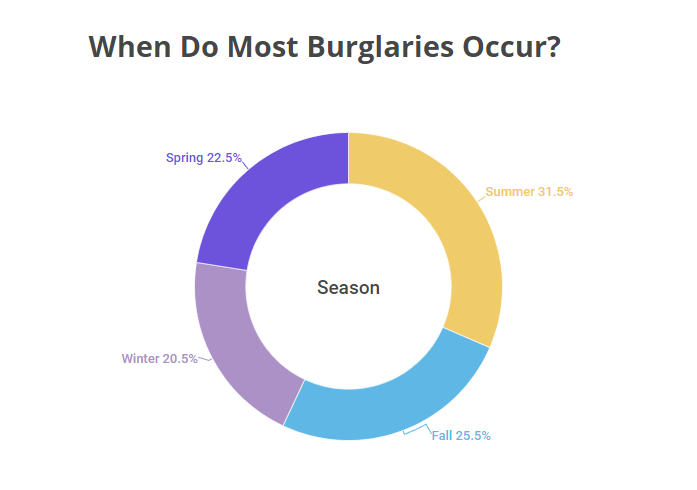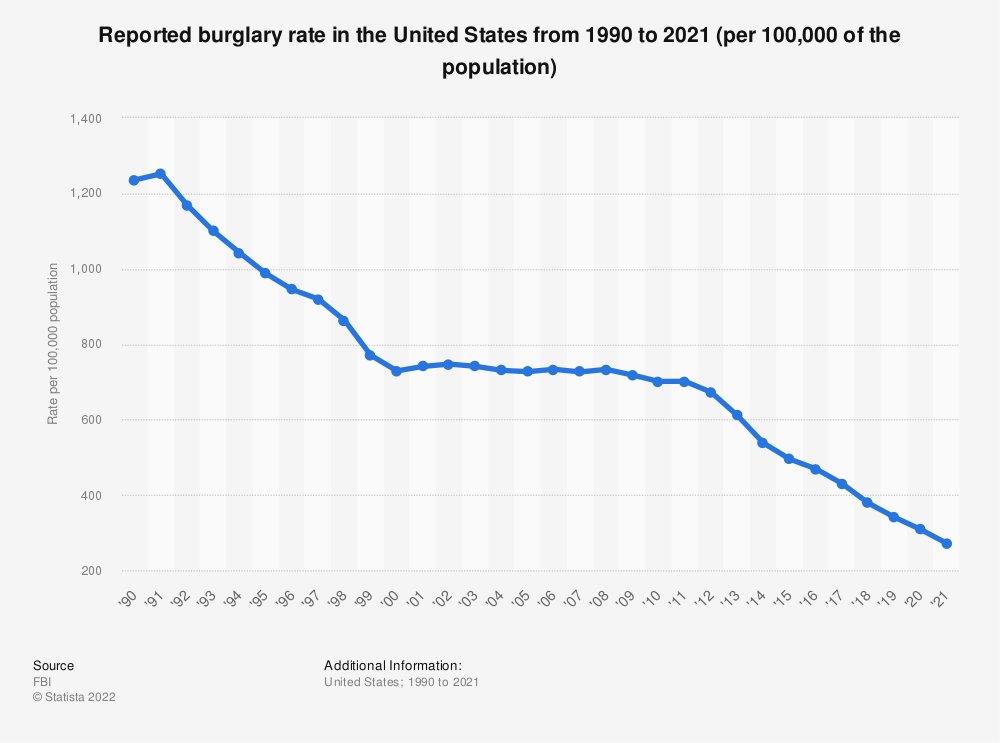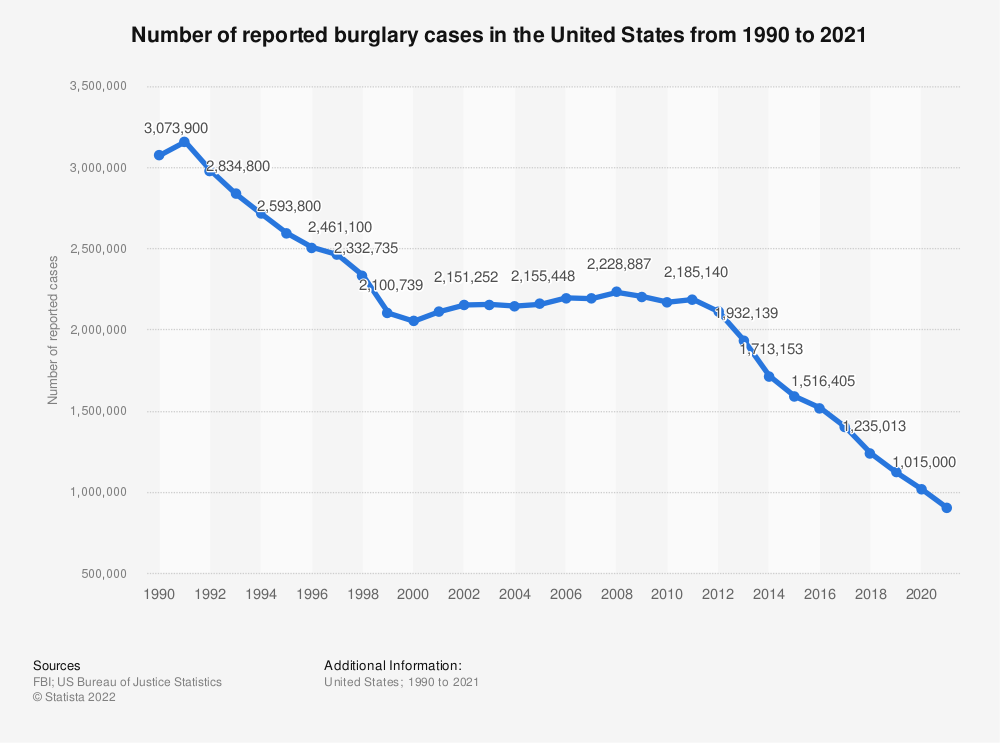We all want our homes and family to be safe. However, we often tend to believe that bad things happen to others but not to us.
The truth is that you can’t always prevent a burglary or a home invasion but you can, indeed, significantly reduce the chance of it happening by taking some simple preventative measures.
That’s when home burglary statistics come in: by studying intruders’ habits, you can be one step ahead of them. Data can also help you understand important correlations and patterns of burglaries that will definitely make your job easier when it comes to making your home safer and more burglar-proof.
Statistics can even help you find the weak points of your home so you can focus on those first in order to improve security.
While it’s true that the number of burglaries has reduced in the last few years, there are still more than 3,000 break-ins each day, on average, in the U.S. (1).
That’s why it’s so important to be familiar with burglary facts and figures: they show what crooks exactly look for in a house and how to successfully deter them.
1. What Time of Day Do Most Break-Ins Occur?
Many people think burglars are more active at night in the dark. As it turns out, the exact opposite is true: according to statistics, 65% of burglaries occur during daylight, between 6 a.m. and 6 p.m. (2).
The timeframe between 10 a.m. and 3 p.m. on weekdays is especially popular among intruders (3). This is when most people are at work or school and their homes are empty.
On the other hand, burglars are more active in the summer months: most break-ins occur in July and August when many people are on vacation. Data from 17 consecutive years (from 1993 to 2010) show that, on average, home burglary rates are about 6% lower in fall, 9% lower in spring, and 11% lower in winter than in the summer months (4).

Security Tip: Make sure you always lock the doors when you leave home. Burglars usually look for easy targets, so often you can deter them by reinforcing your doors and windows or by installing a real or a dummy security camera. The vast majority of burglars avoid homes that are not empty, so it’s a good idea to pretend someone is at home when you’re away for a longer time. We’ve collected some of the best methods to deter burglars in this article.
2. How Do Most Burglars Break Into Homes?
Most intruders (about 34%) get into homes through the front door. Usually, they simply kick it open but it’s not uncommon that they find themselves with an unlocked door. The second and third most common entry points are first-floor windows and back doors: 23% and 22% of burglars, respectively, choose these entrances to get into a home (5).
So we can assume that most burglars use either a door or a first-floor window to break into homes. Therefore, the first thing you want to do is make sure your doors and windows are secured properly.

You can easily and significantly improve front door security on the cheap just by replacing the deadbolt strike plate and reinforcing the hinges. We have a full post on how you can secure your front door here with many actionable tips. Make sure you also check out our article on the best methods to kick-proof your doors.
3. Where Do Most Burglars Head For After Getting Into Homes?
Once crooks get into a home, they want to collect as many valuables as possible in as little time as possible. Therefore, most of them head straight for the master bedroom where they usually search for jewelry, cash, and other small and expensive items (6).
In a survey, burglars were asked where they looked first for valuables: 75% of them answered that they headed first for the bedroom. Only 19% started searching in the living room.
Conclusion?
It’s always a good idea to hide your valuables but it’s especially true if you keep them in your bedroom. If you use a safe, you want to make sure you conceal it rather than keeping it in a place where it can be easily spotted by intruders (no matter how firmly you fix your safe or how secure it is, if it’s not hidden, crooks will try their best to crack it open). We have collected the best secret places to hide a safe in this article.
Here’s a video every homeowner should watch to better understand how burglars choose their targets:
4. Do Burglars Return? What Are the Chances of a Repeat Burglary?
Burglary statistics show that criminals often return to the same house (or apartment), especially if no intervention has been made to improve security.
In fact, one out of three burglaries is a repeat burglary. So once burglarized, there’s a pretty high chance of a second attempt. It’s good to know that criminals usually return within one month after the first successful break-in (7).
Do burglars return after a failed attempt?
It usually depends on the reason behind the failure. If a burglar gets caught by the owner, it’s not very probable that they will return. On the other hand, if the reason for the failure was bad timing or an unexpected level of security, they might come back with a more detailed plan or the proper equipment they need to get into the house.
Bottom line?
If your home is burglarized, do not hesitate to improve security as soon as possible because there’s a real chance that the same burglar (or another one taking advantage of the same vulnerability of your home) will return.
If you notice or get notified that there was a failed attempt, you should look for the weak points of your house and reinforce them as soon as you can. Pay special attention to sliding doors because in most cases those are very easy to bypass: many of them can be lifted out of their tracks in no time (you can find a quick guide on how you can improve sliding door security here).
5. How Often Do Burglars Break Windows?
While it’s true that the second most common points of entry are first-floor windows, most burglars prefer not to smash any glass to get into a house, and for good reason: breaking a window is noisy.
On the other hand, windows often come with poor latches that can be easily compromised. Not to mention those cases when a window is left open (it’s more common than you might think). Thus, if intruders want to get into a house through a window, they usually have better options than smashing the glass.
However, have no doubt that many burglars won’t hesitate to break a window if they can’t find any other option. You can prevent this scenario by installing security film or security screens, for instance. We have a full guide on all the best methods to secure your windows here.
6. How Many Home Burglaries Occur Each Year According to Statistics?
According to the database of the FBI, there are approximately 3,062 burglaries each day on average in the U.S. In 2019, an estimated 1,117,696 burglaries occurred in the country, 55.7 percent of which involved forcible entry.
So the average reported home burglary rate per 100,000 inhabitants was 337.
Now let’s see the numbers in each state.
Burglary Rate per 100,000 Inhabitants in the U.S. States
As you’ll see, the rate of burglary varies widely between states. There’s more than a sixfold difference between the states with the highest and lowest burglary rates.
According to home burglary statistics, you have the greatest chance of being burglarized if you live in New Mexico, Oklahoma, or Arkansas: these are the top three states with the highest burglary rates.
On the other hand, New Hampshire, Virginia, and New Jersey have the lowest rate of burglary in the whole country.

Top 50 Metropolitan Areas With The Highest Burglary Rate In the United States
You’ll see even bigger differences between the metropolitan areas regarding burglary rates:
7. What Are the Trends? Burglary Statistics From 1990 to the Present
The good news is that the number of burglaries is definitely decreasing across the whole country. Fewer homes are broken into each year. While in 1990 there were more than 3 million burglaries in the U.S., by the year 2019 this number has decreased by 62% to about 1.12 million.
When compared with data from 2015, the number of burglaries dropped by 29.6%. So the trend is clearly downward, however, that doesn’t mean you can ignore home security.
Although the trend is actually favorable, the burglary rate in the U.S. is still pretty high compared to some European countries. So there’s still room for improvement.
If you’re more of a visual type, you can clearly see the downward trend in burglary rates on the graph below:

And here you can check out the total number of reported burglaries in the U.S. year by year:

8. What Is the Average Loss per Burglary?
According to the latest statistics, a burglary victim loses an average of $2,661 (8). That can be a whole month’s earnings for many people. Not to mention the damages a burglar might cause while trying to get into a home. And then there are the psychological effects of burglary or, even worse, robbery which can be very hard on some people.
When it comes to home security, prevention always pays off. You can secure all your doors and windows for a fraction of the potential damage.
Check out this article for some simple DIY home security hacks.
9. How Long Does an Average Burglary Last?
It does not last long. In fact, most burglaries are committed in between 90 seconds and 12 minutes, however, the typical timeframe is between 8 and 10 minutes (9).
That’s usually enough time to find some cash and valuables in most homes. If you conceal your valuable items (or at least if you don’t keep them in obvious places), you can significantly reduce the damage in case of a break-in.
Here is another reason to take prevention seriously: about 90% of burglars are never caught, so once they’re gone, chances are great that you’ll never see your valuables again.
Putting It All Together
As you can see, statistics show a clear decline in the number of home burglaries in the U.S., however, there’s still room for improvement. Thus, improving security is still important and shouldn’t be taken lightly.
Burglars are more active during daylight (between 6 a.m. and 6 p.m.) and in the summer months when most people are on a vacation.
Most criminals use the front door to get into a house (or apartment), however, first-floor windows and back doors are also popular. Once inside, they usually head straight for the master bedroom and look for cash and small valuable items.
Crooks often return to the same house within just a few weeks (usually within one month) after a successful burglary. Often you can expect a second visit after a failed attempt too.
While it’s true that any door, window, or security system can be compromised, burglars almost always choose the easier target. Most of them are not professional criminals and they often get into a home by simply kicking the door open (or through an unlocked door).
Therefore, practically any security improvement can contribute to preventing home invasions. So make sure you have at least some basic protection in your home and if you don’t, start by reinforcing your doors and windows. Believe me, it’s well worth the effort.












